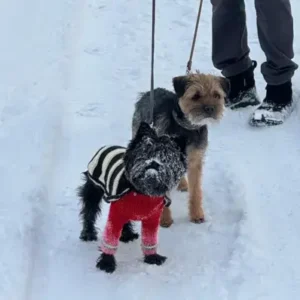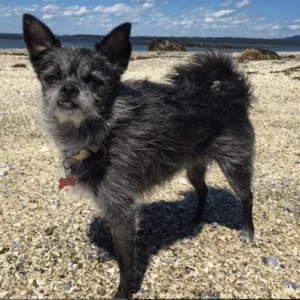Schnoodle History/Origin
The Schnoodle was created in the 1980s, following the growing interest in Poodle crosses, to produce a low-shedding, low-dander family dog. Although it hasn’t reached the popularity of other hybrid dog breeds, there is a strong following for Schnoodles, driving demand for puppies.
Typically bred from a Schnauzer and Poodle, some breeders now create multigenerational Schnoodles. While there are no official breed clubs or standards yet, efforts to establish them are underway.
Schnoodles come in a variety of sizes due to the different sizes of Poodles and Schnauzers. The most recent variation, incorporating the Giant Schnauzer and Standard Poodle, produces a dog with a different temperament from the traditional small, cuddly Schnoodle.
Schnoodle Personality
Schnoodles are one of the dog breeds known for their charming, entertaining, and alert nature, combining the best traits of both the Poodle and Schnauzer. They are highly intelligent, making them easy to train and quick to learn new commands.
This breed is also incredibly affectionate and loves to be around their family, often forming close bonds with their owners.
- Potential Challenges
While Schnoodles are typically well-behaved, their behavior can be heavily influenced by the level of socialization they receive as puppies. Without early socialization, Schnoodles may become hesitant or anxious in unfamiliar situations or around new people, which can lead to behavioral issues such as excessive barking or shyness.
Proper early exposure to various environments, people, and pets will help them grow into confident and well-adjusted dogs. Schnoodles generally get along with other pets, but their behavior around unfamiliar dogs will depend on their socialization experience.
Training is essential for Schnoodle dogs, and positive reinforcement methods—such as treats and praise—are the most effective. Schnoodles are eager to please and respond well to reward-based training. However, inconsistency in training or the use of harsh methods can cause confusion or anxiety in the dog, leading to undesirable behavior. Consistent training, along with early socialization, helps Schnoodles develop into well-mannered and confident dogs.
Schnoodle Physical Appearance
Schnoodles have square bodies with slightly sloping straight backs. Their feet resemble cat paws, and their tails are carried upright when happy, or tucked when nervous or sad. Their heads are medium-width, tapering toward a smaller muzzle. They have dark brown, round or oval eyes, medium-sized ears folded into a V-shape, and a scissors bite where the teeth meet.
- Size
The size of a Schnoodle depends on its parents. For example, a Standard Poodle crossed with a Giant Schnauzer will produce larger offspring, while crossing a Standard Poodle with a Standard Schnauzer may result in sizes ranging between Miniature and Standard Schnoodles. Due to the lack of breed standards, predicting adult size is uncertain, but most Schnoodles typically weigh 20 pounds or less.
- Toy Schnoodles: 10-12 inches, 6-10 pounds
- Miniature Schnoodles: 12-15 inches, 13-20 pounds
- Standard Schnoodles: 15-26 inches, 20-75 pounds
- Giant Schnoodles: 20-28 inches, 50-110 pounds
- Coat color
The Schnoodle coat can come in various colors, including black, gray, silver, brown, white, apricot, sable, black and white, black and tan, and even parti-color.
The soft, wavy coat is designed to resemble a Schnauzer puppy’s. In first-generation Schnoodles, the coat remains soft and wavy throughout their lives, unlike the wiry coat of an adult Schnauzer or the tight curls of a Poodle. However, second-generation Schnoodles are more likely to inherit the curly coat of the Poodle or the wiry coat of the Schnauzer. The soft, wavy coat is more common in multigenerational breeding.
Grey Schnoodle- Source: Pixabay
White Schnoodle- Source: leelootheschnoodle
Black Schnoodle- Source: stantheschnoodle
Fawn Schnoodle- Source: kinako7216
Schnoodle Gender Differences
There are a few differences between male and female Schnoodles that you should be aware of. Males tend to be larger than females, mainly due to the size of their parents and which breed they take after. Generally, males from the same litter are larger than the females.
Another difference is that males often require more attention and can be more demanding than females. While females still need attention, they typically expect you to approach them, whereas males will actively seek out your attention. This can vary based on individual personalities, but on average, males tend to be more attention-seeking.
Schnoodle Feed/Nutrition
Feed your Schnoodle 3/4 to 1 cup of high-quality dry food daily if they weigh between 15 to 20 pounds. If your Schnoodle is smaller, feed less; if you have a Giant Schnauzer parent, feed more. To maintain a healthy weight, measure their food and feed them twice or three times a day, rather than leaving food out all the time.
Consult your vet to tailor the food amount based on your dog’s size, age, metabolism, and activity level. Highly active dogs will need more food, while less active dogs need less. The quality of food matters — better food provides more nutrition, requiring less quantity.
Minimize processed foods and consider adding human-grade food and fresh vegetables, like broccoli, for better health. If your Schnoodle has health issues like allergies or skin problems, ask your vet about switching to a vegetarian diet.
Schnoodle Health
Although the Schnoodle is generally a healthy breed, often even healthier than purebreds, there are a few conditions to watch for. If you observe any of the following issues or unusual behavior in your dog, it’s important to take them to the vet promptly.
- Progressive Retinal Atrophy: PRA is a group of eye diseases that cause the retina to deteriorate, leading to night blindness and eventually total vision loss. While it’s often inherited, dogs with PRA can adapt to their limited vision as long as their environment remains consistent. Regular vet checkups and early diagnosis can help manage the condition, and dogs may thrive in familiar settings with minimal changes.
- Cataracts: Cataracts cause cloudiness on the lens of the eye, leading to poor vision, especially in older dogs. Cataracts can sometimes be surgically removed to restore vision. Regular veterinary eye exams can catch cataracts early, and surgery may be recommended if the dog’s quality of life is affected by vision loss.
- Legg-Calve-Perthes Disease: This condition affects the hip joint, where the blood supply to the femur is reduced, causing the bone to deteriorate. Symptoms like limping and muscle atrophy typically appear when puppies are between four to six months old. Surgery can correct this condition, allowing the dog to recover and live pain-free.
- Patellar Luxation: Patellar luxation, or slipped stifles, occurs when the kneecap moves in and out of place, often causing pain. This is common in small dogs and can lead to mobility issues if untreated. Preventive measures include maintaining a healthy weight and avoiding excessive jumping, while surgical intervention may be needed for severe cases.
- Epilepsy: Epilepsy causes seizures, ranging from mild to severe, and can be inherited or result from other factors. Symptoms may include unusual behavior or sudden collapses. If your Schnoodle has seizures, visit the vet for diagnosis and treatment, as many dogs with epilepsy live normal lives with proper care.
- Diabetes: Diabetes mellitus occurs when a dog’s body cannot regulate blood sugar levels due to insufficient insulin production. Symptoms include excessive thirst, urination, and weight loss. Diabetes can be managed through a balanced diet, insulin therapy, and regular veterinary monitoring to maintain healthy blood sugar levels.
- Addison’s Disease: Addison’s disease is a serious condition where the adrenal glands fail to produce enough hormones. Symptoms include vomiting, lack of energy, and loss of appetite. If you notice any of these signs, consult your vet for blood tests and a proper diagnosis, as Addison’s can be treated with medication and hormone replacement therapy.
- Canine Gastric Torsion: Gastric torsion, or bloat, occurs when the stomach fills with gas and twists, blocking blood flow and causing shock. While it’s more common in large, deep-chested dogs, Schnoodles with Giant Schnauzer genes may be at risk. To prevent bloat, avoid feeding one large meal per day, limit vigorous exercise after meals, and ensure your dog eats slowly and doesn’t drink excessive water immediately after eating.
Schnoodle Care and Grooming
Schnoodles are low-shedding but still need regular grooming. The amount of care depends on their coat type. If your Schnoodle has a soft, wavy coat, brush once or twice a week to prevent tangles and bathe as needed to keep it soft.
For a wiry Schnauzer-style coat, weekly brushing and occasional trimming are enough. A Schnoodle with a curly Poodle coat requires regular brushing and should be clipped every six to eight weeks.
Keep their facial hair trimmed and clean to avoid food buildup. Check ears weekly for dirt, redness, or odor, and clean them with a damp cotton ball to prevent infections. Brush their teeth two to three times a week to prevent tartar and bacteria buildup. Trim nails regularly if they don’t wear down naturally.
Start grooming your Schnoodle early, making it a positive experience with praise and rewards. Regular exams will help spot potential health issues such as sores, rashes, or infections.
As for exercise, Schnoodles need about 30 to 60 minutes of activity daily, which may vary based on the individual dog. They enjoy brisk walks and can be great jogging companions.
Schnoodles adapt well to different living situations, but a home with a fenced yard is ideal. Toy and Miniature Schnoodles are suited for apartments, while Standard Schnoodles need more space. They shouldn’t be left outside or in a kennel as they are companion dogs. Training your dog to stay helps ensure they remain calm and settled when left alone for short periods.
Schnoodle Rescue Groups
Since Schnoodles are a hybrid breed of Schnauzers and Poodles, there aren’t many rescue groups specifically for them. If you’re interested in rescuing a Schnoodle, check with both Schnauzer and Poodle rescue groups, as these organizations sometimes take in mixed breeds, including Schnoodles. Rescuing offers a great chance to give a loving home to a dog in need, often with the added benefit of adult dogs who may already have some training.
Schnoodle Price
The price of a Schnoodle typically ranges from $500 to $2,000, depending on factors such as breeder reputation, pedigree, and location.
If you’re looking to purchase a Schnoodle, it’s essential to find a reputable breeder who follows ethical breeding practices. Ethical breeders will also provide a clean, nurturing environment for the puppies, ensuring they are well-socialized and ready to join a new family. Avoid breeders who prioritize profit over the well-being of their dogs or who can’t provide clear health documentation.
Interesting Facts
- Schnoodles may look cute and cuddly, but both Schnauzers and Poodles are working breeds—meaning they’re not couch potatoes!
- Thanks to their Schnauzer and Poodle heritage, Schnoodles are incredibly smart, often excelling in obedience training and even dog sports.
Best For
The Schnoodle is ideal for individuals or families who want an affectionate, intelligent, and active companion. They thrive with people who can provide consistent attention, regular exercise, and enjoy training or interactive play. Given their social nature, Schnoodles are best suited for those who are often home or can dedicate time to prevent boredom and potential separation anxiety.
Top Names
| Male Schnoodle Names | Female Schnoodle Names |
| Max | Bella |
| Charlie | Daisy |
| Teddy | Luna |
| Finn | Zoey |
| Milo | Ruby |









 Schnauzer – Source:
Schnauzer – Source:  Poodle- Source:
Poodle- Source: 
 Grey Schnoodle- Source:
Grey Schnoodle- Source:  White Schnoodle- Source:
White Schnoodle- Source:  Black Schnoodle- Source:
Black Schnoodle- Source:  Fawn Schnoodle- Source:
Fawn Schnoodle- Source: 







